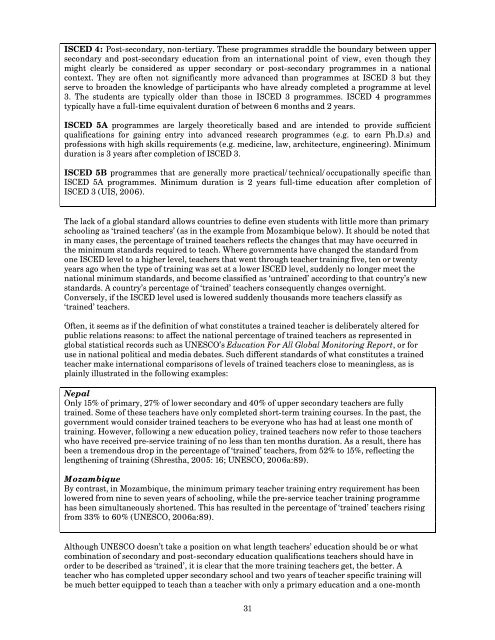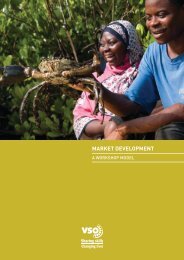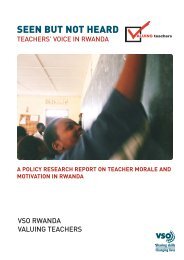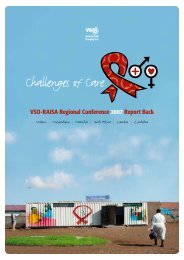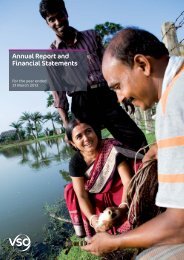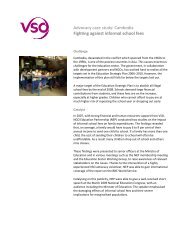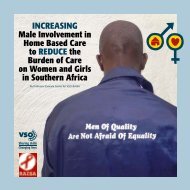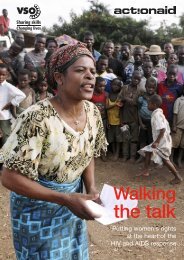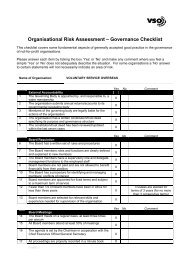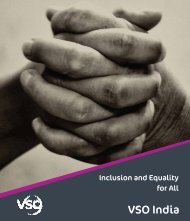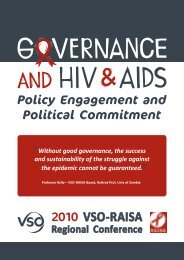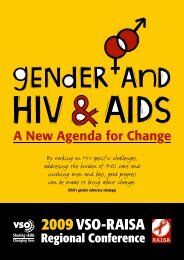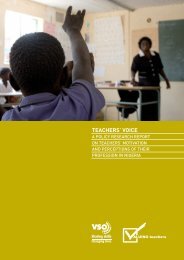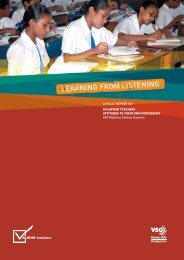Teachers for All â GCE policy briefing (566KB) - VSO
Teachers for All â GCE policy briefing (566KB) - VSO
Teachers for All â GCE policy briefing (566KB) - VSO
Create successful ePaper yourself
Turn your PDF publications into a flip-book with our unique Google optimized e-Paper software.
ISCED 4: Post-secondary, non-tertiary. These programmes straddle the boundary between uppersecondary and post-secondary education from an international point of view, even though theymight clearly be considered as upper secondary or post-secondary programmes in a nationalcontext. They are often not significantly more advanced than programmes at ISCED 3 but theyserve to broaden the knowledge of participants who have already completed a programme at level3. The students are typically older than those in ISCED 3 programmes. ISCED 4 programmestypically have a full-time equivalent duration of between 6 months and 2 years.ISCED 5A programmes are largely theoretically based and are intended to provide sufficientqualifications <strong>for</strong> gaining entry into advanced research programmes (e.g. to earn Ph.D.s) andprofessions with high skills requirements (e.g. medicine, law, architecture, engineering). Minimumduration is 3 years after completion of ISCED 3.ISCED 5B programmes that are generally more practical/technical/occupationally specific thanISCED 5A programmes. Minimum duration is 2 years full-time education after completion ofISCED 3 (UIS, 2006).The lack of a global standard allows countries to define even students with little more than primaryschooling as ‘trained teachers’ (as in the example from Mozambique below). It should be noted thatin many cases, the percentage of trained teachers reflects the changes that may have occurred inthe minimum standards required to teach. Where governments have changed the standard fromone ISCED level to a higher level, teachers that went through teacher training five, ten or twentyyears ago when the type of training was set at a lower ISCED level, suddenly no longer meet thenational minimum standards, and become classified as ‘untrained’ according to that country’s newstandards. A country’s percentage of ‘trained’ teachers consequently changes overnight.Conversely, if the ISCED level used is lowered suddenly thousands more teachers classify as‘trained’ teachers.Often, it seems as if the definition of what constitutes a trained teacher is deliberately altered <strong>for</strong>public relations reasons: to affect the national percentage of trained teachers as represented inglobal statistical records such as UNESCO’s Education For <strong>All</strong> Global Monitoring Report, or <strong>for</strong>use in national political and media debates. Such different standards of what constitutes a trainedteacher make international comparisons of levels of trained teachers close to meaningless, as isplainly illustrated in the following examples:NepalOnly 15% of primary, 27% of lower secondary and 40% of upper secondary teachers are fullytrained. Some of these teachers have only completed short-term training courses. In the past, thegovernment would consider trained teachers to be everyone who has had at least one month oftraining. However, following a new education <strong>policy</strong>, trained teachers now refer to those teacherswho have received pre-service training of no less than ten months duration. As a result, there hasbeen a tremendous drop in the percentage of ‘trained’ teachers, from 52% to 15%, reflecting thelengthening of training (Shrestha, 2005: 16; UNESCO, 2006a:89).MozambiqueBy contrast, in Mozambique, the minimum primary teacher training entry requirement has beenlowered from nine to seven years of schooling, while the pre-service teacher training programmehas been simultaneously shortened. This has resulted in the percentage of ‘trained’ teachers risingfrom 33% to 60% (UNESCO, 2006a:89).Although UNESCO doesn’t take a position on what length teachers’ education should be or whatcombination of secondary and post-secondary education qualifications teachers should have inorder to be described as ‘trained’, it is clear that the more training teachers get, the better. Ateacher who has completed upper secondary school and two years of teacher specific training willbe much better equipped to teach than a teacher with only a primary education and a one-month31


